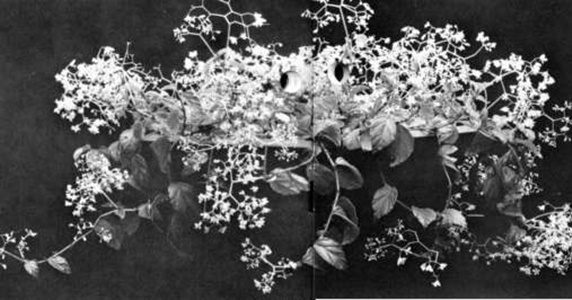Trailing-scandent begonias grow vine-like, usually with many branches, and lend themselves superbly to hanging baskets or being trained up posts, trellises, and “totem poles.” Most are packed with small leaves and bloom in clusters more or less profusely, the flowering season varying from plant to plant.
These begonias are good subjects to grow hanging from tree limbs, under lath covers or greenhouse roofs, and in front of large windows.
Some trailing-scandent begonias you may find are B. convulvulacea, B. ‘Ellen Dee’, B. ‘Elsie M. Frey’, B. fagifolia, B. glabra, B. mannii, B. ‘Marjorie Daw’, B. polygonoides, B. procumbens, B. ‘Shippy’s Garland’, and B. ‘Splotches’.
These begonias need plenty of light, even some sunlight, but no intense midday sun. Good light will help produce a full plant with lots of bloom. If leaf stems elongate and the space between stem joints gets larger, you know the plant needs more light. If the foliage pales, you are providing excessive light.
The usual comfortable temperature range for people, 58 to 72 degrees F., is right for trailing-scandent begonias. The humidity requirement is average for begonias — 40 to 60 percent or so.
Potting is more crucial than with some other begonias because the long, pendulous stems are sometimes fragile. if you use plastic containers, be careful not to overwater. Some feel clay, wood, or moss-lined wire baskets are better. A squat or somewhat shallow container is best, because the begonias are shallow rooted.
Don’t overpot. When potting up, put a plant in a new container only one size larger than the present one. Too much extra space can produce weak plants and retain so much water plants drown.
Staking isn’t necessary, but pruning and pinching can make the difference between a so-so plant and a great one. Prune out old stems with long bare sections. Pinch stems often to encourage branching and to obtain stems of varying lengths resulting in a full, shapely plant.
Water when the planter mix feels dry to the touch. If weather is warm or the plant seems to dry out faster than other begonias because it is in a hanging basket, water a bit more frequently. Spraying leaves with water in the morning increases humidity and washes off dust. A complete fertilizer used throughout the active growing season should be supplemented just before and during the blooming season with a high-phosphorus food.
Trailing-scandent begonias can be propagated easily using stem cuttings, especially tip cuttings you create when you pinch and prune.


